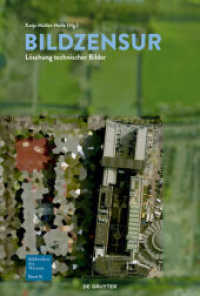- ホーム
- > 洋書
- > 英文書
- > Computer / General
Full Description
Virtual Reality is not real life. Instead it is life-like creations using computer-generated scenarios. Human behavior is replicated in virtual scenarios, where every detail is controlled by computers, and in situations that can be repeated under the same conditions.
Based on technology and design, the user can experience presence. In the virtual world, users are embodied in avatars that represent them and are the means to interact with the virtual environment. Avatars are graphical models that behave on behalf of the human behind them. The user avatar is a proxy that also backs interaction with others, allowing computer-mediated interactions.
Analyses directed to understand people's perceptions, personal and social behavior in computer mediated interactions, comprise a multidisciplinary area of study that involves, among others, computer science, psychology and sociology. In the last two decades a number of studies supported by Virtual Reality have been conducted to understand human behavior, in some cases the implications of the technology, or to reproduce artificial human behavior. This book presents a collection of studies from recognized researchers in the area.
Contents
Virtual reality as a tool for behavior analysis and applications. Navigating in Virtual Reality. User modeling systems adapted to virtual environments. Synthetic Perception and Decision-Making for Autonomous Virtual Humans in Virtual Reality Applications. An internal model for characters in Virtual Environments: emotion, mood and personality. Pedagogical agents as virtual tutors: applications and future trends in Intelligent Tutoring Systems and Virtual Learning Environments. Gamification in Virtual Reality Environments for the integration of highly effective teams. Integrating Virtual Reality into Learning-Objects based courses. Virtual simulation of road traffic based on Multi-agent systems. The sense of touch as the last frontier in Virtual Reality technology.







